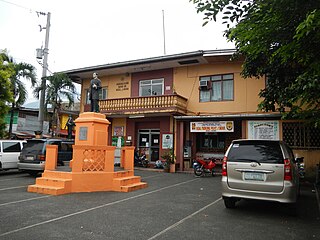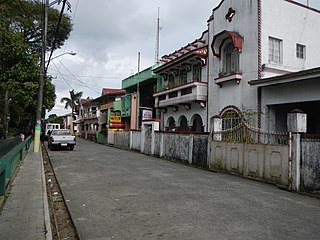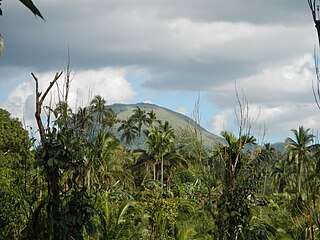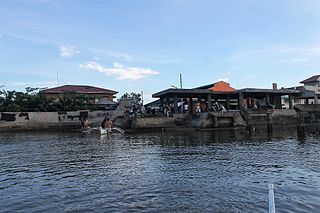Calauan | |
|---|---|
| Municipality of Calauan | |
 Downtown area of Calauan | |
| Nickname: Home of the Sweet Laguna Pineapple [1] | |
 Map of Laguna with Calauan highlighted | |
Location within the Philippines | |
| Coordinates: 14°09′N121°19′E / 14.15°N 121.32°E | |
| Country | Philippines |
| Region | Calabarzon |
| Province | Laguna |
| District | 3rd district |
| Barangays | 17 (see Barangays) |
| Government | |
| • Type | Sangguniang Bayan |
| • Mayor | Roseller G. Caratihan |
| • Vice Mayor | Allan Jun V. Sanchez |
| • Representative | Loreto S. Amante |
| • Municipal Council | Members |
| • Electorate | 46,467 voters (2022) |
| Area | |
| • Total | 65.40 km2 (25.25 sq mi) |
| Elevation | 124 m (407 ft) |
| Highest elevation | 1,084 m (3,556 ft) |
| Lowest elevation | 2 m (7 ft) |
| Population (2020 census) [4] | |
| • Total | 87,693 |
| • Density | 1,300/km2 (3,500/sq mi) |
| • Households | 21,374 |
| Demonym | Calaueño |
| Economy | |
| • Income class | 2nd municipal income class |
| • Poverty incidence | 4.04 |
| • Revenue | ₱ 241.3 million (2020) |
| • Assets | ₱ 803.7 million (2020) |
| • Expenditure | ₱ 159.2 million (2020) |
| • Liabilities | ₱ 136.3 million (2020) |
| Service provider | |
| • Electricity | Manila Electric Company (Meralco) |
| Time zone | UTC+8 (PST) |
| ZIP code | 4012 |
| PSGC | |
| IDD : area code | +63 (0)49 |
| Native languages | Tagalog |
| Website | www |
Calauan (IPA: [kalawan] ), officially the Municipality of Calauan (Tagalog : Bayan ng Calauan), is a 2nd class municipality in the province of Laguna, Philippines. The municipality has a land area of 25.25 square miles which constitutes 3.41% of Laguna's total area. According to the 2020 census, it has a population of 87,693 people. [4]
Contents
- Etymology
- History
- Geography
- Geographical landmarks
- Barangays
- Climate
- Demographics
- Economy
- Government
- References
- External links
Situated at 73 kilometers (45 mi) southeast of Manila, via Calamba and Los Baños, and 26 kilometers (16 mi) from Santa Cruz. Calauan is known for the Pineapple Festival, which is celebrated every 15 May.
The patron saint of Calauan is Isidore the Laborer, the patron of farmers, known in Spanish as San Isidro Labrador.
Calauan's population is expected to rise, as the town is being used as resettlement of informal settlers in Metro Manila through the Bayan ni Juan and the Kapit-Bisig para sa Ilog Pasig project of the ABS-CBN Foundation.
Popular destinations in the area include the Field of Faith situated in Barangay Lamot 2 and the Isdaan Floating Restaurant located along the Calamba–Pagsanjan Road.



























